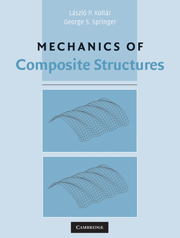Book contents
- Frontmatter
- Contents
- Preface
- List of Symbols
- 1 Introduction
- 2 Displacements, Strains, and Stresses
- 3 Laminated Composites
- 4 Thin Plates
- 5 Sandwich Plates
- 6 Beams
- 7 Beams with Shear Deformation
- 8 Shells
- 9 Finite Element Analysis
- 10 Failure Criteria
- 11 Micromechanics
- Appendix A Cross-Sectional Properties of Thin-Walled Composite Beams
- Appendix B Buckling Loads and Natural Frequencies of Orthotropic Beams with Shear Deformation
- Appendix C Typical Material Properties
- Index
1 - Introduction
Published online by Cambridge University Press: 01 September 2009
- Frontmatter
- Contents
- Preface
- List of Symbols
- 1 Introduction
- 2 Displacements, Strains, and Stresses
- 3 Laminated Composites
- 4 Thin Plates
- 5 Sandwich Plates
- 6 Beams
- 7 Beams with Shear Deformation
- 8 Shells
- 9 Finite Element Analysis
- 10 Failure Criteria
- 11 Micromechanics
- Appendix A Cross-Sectional Properties of Thin-Walled Composite Beams
- Appendix B Buckling Loads and Natural Frequencies of Orthotropic Beams with Shear Deformation
- Appendix C Typical Material Properties
- Index
Summary
In this book we focus on fiber-reinforced composites composed of fibers embedded in a matrix. The fibers may be short or long, continuous or discontinuous, and may be in one or in multiple directions (Fig. 1.1). Such materials offer advantages over conventional isotropic structural materials such as steel, aluminum, and other types of metal. These advantages include high strength, low weight, and good fatigue and corrosion resistance. In addition, by changing the arrangements of the fibers, the properties of the material can be tailored to meet the requirements of a specific design.
The excellent properties of composites are achieved by the favorable characteristics of the two major constituents, namely the fiber and the matrix. In low-performance composites, the reinforcements, usually in the form of short or chopped fibers (or particles), provide some stiffening but very little strengthening; the load is mainly carried by the matrix. In high-performance composites, continuous fibers provide the desirable stiffness and strength, whereas the matrix provides protection and support for the fibers, and, importantly, helps redistribute the load from broken to adjacent intact fibers.
The arrangement of the fibers in a structure is governed by the structural requirements and by the process used to fabricate the part. Frequently, though not always, composite structures are made of thin layers called laminae or plies. Within each lamina, the fibers may be aligned in the same direction (unidirectional ply, Fig. 1.1) or in different directions.
- Type
- Chapter
- Information
- Mechanics of Composite Structures , pp. 1 - 2Publisher: Cambridge University PressPrint publication year: 2003



